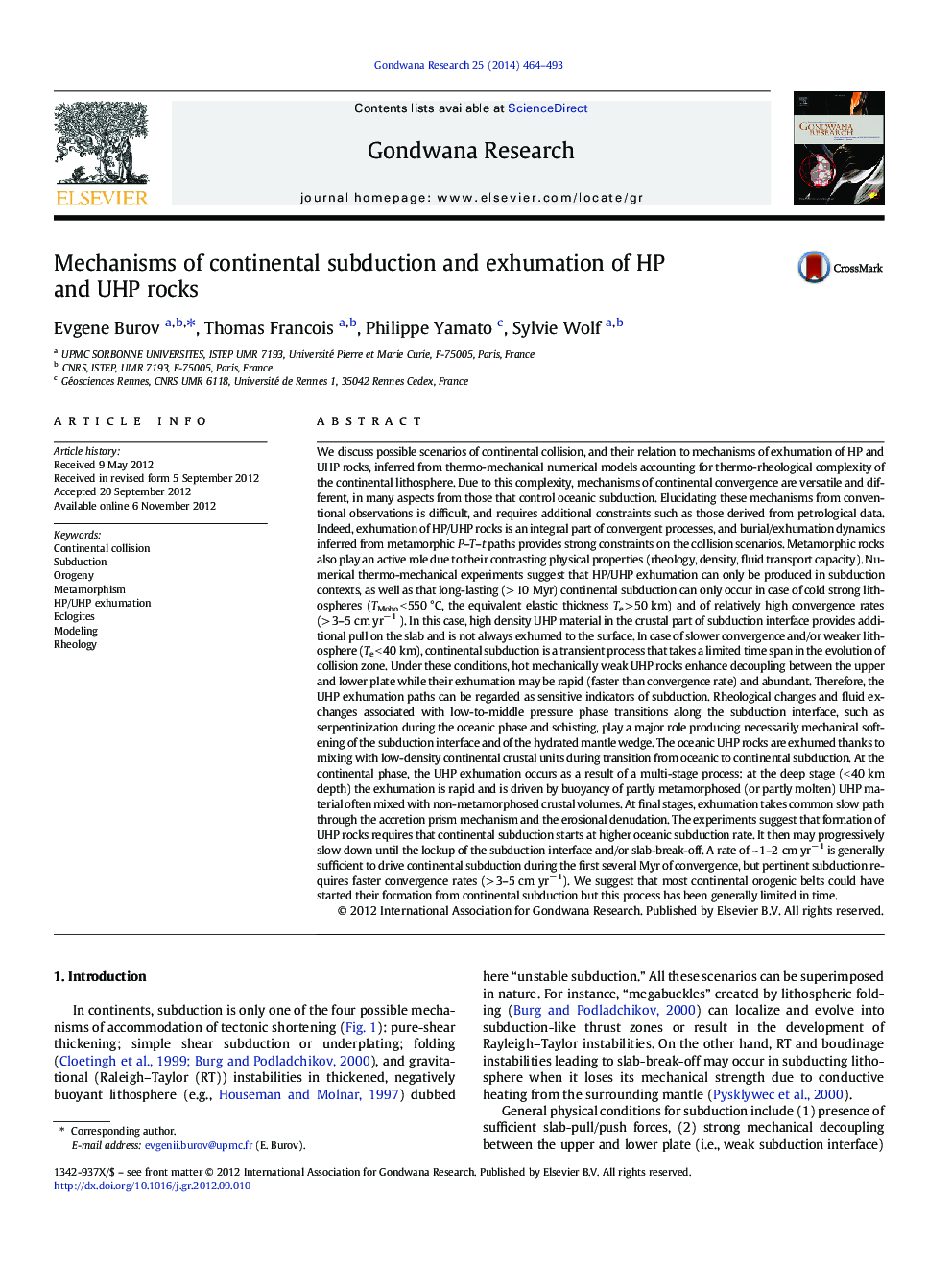| کد مقاله | کد نشریه | سال انتشار | مقاله انگلیسی | نسخه تمام متن |
|---|---|---|---|---|
| 4727084 | 1356360 | 2014 | 30 صفحه PDF | دانلود رایگان |

We discuss possible scenarios of continental collision, and their relation to mechanisms of exhumation of HP and UHP rocks, inferred from thermo-mechanical numerical models accounting for thermo-rheological complexity of the continental lithosphere. Due to this complexity, mechanisms of continental convergence are versatile and different, in many aspects from those that control oceanic subduction. Elucidating these mechanisms from conventional observations is difficult, and requires additional constraints such as those derived from petrological data. Indeed, exhumation of HP/UHP rocks is an integral part of convergent processes, and burial/exhumation dynamics inferred from metamorphic P–T–t paths provides strong constraints on the collision scenarios. Metamorphic rocks also play an active role due to their contrasting physical properties (rheology, density, fluid transport capacity). Numerical thermo-mechanical experiments suggest that HP/UHP exhumation can only be produced in subduction contexts, as well as that long-lasting (> 10 Myr) continental subduction can only occur in case of cold strong lithospheres (TMoho < 550 °C, the equivalent elastic thickness Te > 50 km) and of relatively high convergence rates (> 3–5 cm yr− 1 ). In this case, high density UHP material in the crustal part of subduction interface provides additional pull on the slab and is not always exhumed to the surface. In case of slower convergence and/or weaker lithosphere (Te < 40 km), continental subduction is a transient process that takes a limited time span in the evolution of collision zone. Under these conditions, hot mechanically weak UHP rocks enhance decoupling between the upper and lower plate while their exhumation may be rapid (faster than convergence rate) and abundant. Therefore, the UHP exhumation paths can be regarded as sensitive indicators of subduction. Rheological changes and fluid exchanges associated with low-to-middle pressure phase transitions along the subduction interface, such as serpentinization during the oceanic phase and schisting, play a major role producing necessarily mechanical softening of the subduction interface and of the hydrated mantle wedge. The oceanic UHP rocks are exhumed thanks to mixing with low-density continental crustal units during transition from oceanic to continental subduction. At the continental phase, the UHP exhumation occurs as a result of a multi-stage process: at the deep stage (< 40 km depth) the exhumation is rapid and is driven by buoyancy of partly metamorphosed (or partly molten) UHP material often mixed with non-metamorphosed crustal volumes. At final stages, exhumation takes common slow path through the accretion prism mechanism and the erosional denudation. The experiments suggest that formation of UHP rocks requires that continental subduction starts at higher oceanic subduction rate. It then may progressively slow down until the lockup of the subduction interface and/or slab-break-off. A rate of ~ 1–2 cm yr− 1 is generally sufficient to drive continental subduction during the first several Myr of convergence, but pertinent subduction requires faster convergence rates (> 3–5 cm yr− 1). We suggest that most continental orogenic belts could have started their formation from continental subduction but this process has been generally limited in time.
Figure optionsDownload as PowerPoint slideHighlights
► We study continental subduction and UHP exhumation using advanced numerical models.
► Continental subduction is mainly a transient process.
► During convergence, UHP exhumation happens only at subduction phase.
► UHP exhumation is a poly-phase process driven by viscous buoyancy drag.
► UHP exhumation is favored in slow convergence settings.
Journal: Gondwana Research - Volume 25, Issue 2, March 2014, Pages 464–493